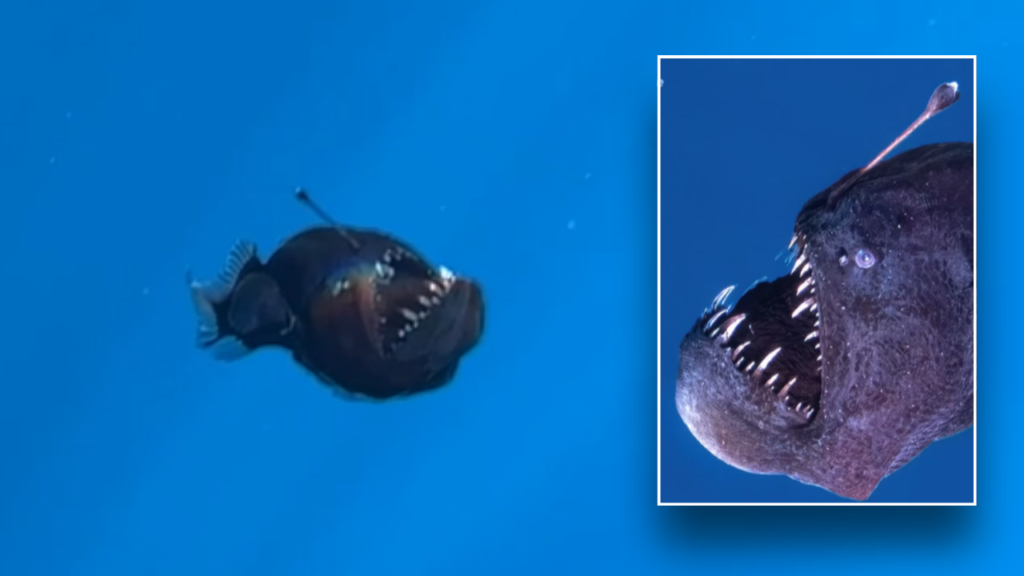A recent sighting of a deep-sea anglerfish in the shallow waters near Tenerife, the largest of Spain’s Canary Islands, has caught the attention of social media users worldwide. The footage was captured on February 13 by David Jara Boguñá, a marine photographer associated with Condrik Tenerife, a Spanish conservation organization. The unusual appearance of the anglerfish, which was swimming vertically in the low depths, sparked tremendous interest online, with the video going viral almost instantaneously.
Jara detailed the fish’s size, noting that the deep-sea creature was much smaller than its ominous photos suggested. He explained that the anglerfish measured no more than about six centimeters, or approximately two inches, stating, “She was more of a black fritter than a black monster.” This comment highlights the surprising contrast between the fish’s menacing reputation and its actual diminutive size. Many people viewing the images had been led to believe the creature was significantly larger, giving rise to fearsome narratives surrounding its appearance.
One of the primary concerns surrounding the anglerfish was whether it posed any danger. Jara addressed this directly, asserting that the fish did not display any aggressive behavior toward him during the encounter. “You’ve asked me this a lot, but at no time did she attack us,” he said, emphasizing that his confusion about the fish’s presence outweighed any fear. He further clarified that this particular specimen was a female, as the males of the species are considerably smaller, measuring only about two to three centimeters and lacking the bioluminescent antennae characteristic of females.
As for why this species, typically dwelling at depths of around 6,000 feet, was found in shallow waters, Jara outlined several hypotheses. Among the theories he shared were that the fish may have been sick, swept upstream by currents, or escaping from predators. Intriguingly, he also noted that the anglerfish might have ingested some prey, which could have caused it to rise to the surface due to gas buildup during digestion.
Additionally, Jara responded to the myriad reactions the sighting elicited on social media, particularly regarding comments linking the fish’s appearance to climate change concerns. He described these notions as “pretentious,” addressing the fears that some users associated with the anglerfish’s emergence as potential harbingers of doom. Unfortunately, he confirmed that the anglerfish did not survive long after its historic sighting; its body was donated to the Tenerife Museum of Nature and Archaeology, allowing for further examination and study.
As news of the fish’s fate spread across social media platforms, it garnered a range of emotional responses. Many users expressed deep sorrow regarding the anglerfish’s demise, leading to an outpouring of artistic and poetic tributes inspired by the creature. Users commented on the poetic nature of the anglerfish’s journey, equating it with a search for light after living in darkness, where one commenter expressed that it was “deeply poetic” to find light, with another vowing to follow in the anglerfish’s quest for enlightenment by enrolling in school.
Conversely, not all users romanticized the situation; some brought a dose of realism to the discussion by reiterating biological facts, suggesting that the fish’s appearance likely indicated it was dying rather than seeking illumination. “This isn’t a Pixar movie,” one user argued, emphasizing the importance of recognizing the natural life processes of these creatures.
The unusual event has illustrated not only the wonders of marine life but also the intricate relationship between humans and the emotional narratives we weave around encounters with such extraordinary beings. It is not often that creatures of the deep are seen alive in shallow waters, underlining the rarity and significance of the anglerfish’s appearance. For those interested in lifestyle articles, further insights can be found at foxnews.com/lifestyle, penned by Fox News Digital journalist Andrea Margolis.











